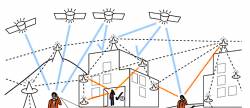The Federal Communications Commission (FCC) is weighing a request to waive spectrum rules for a new ultra-wideband (UWB) device that would operate across a wide swath of frequencies including those used by satellite navigation. The proposal has prompted a call for a wider reconsideration of ultra-wideband limits, a suggestion opposed by the GPS community.
The Federal Communications Commission (FCC) is weighing a request to waive spectrum rules for a new ultra-wideband (UWB) device that would operate across a wide swath of frequencies including those used by satellite navigation. The proposal has prompted a call for a wider reconsideration of ultra-wideband limits, a suggestion opposed by the GPS community.
Israeli firm Kyma Medical Technologies has developed a UWB device it says can be used to non-invasively monitor the fluid levels in the lungs of patients with congestive heart failure by transmitting low-power radio signals through a patient’s torso. The device, named uCor 3.0, sends signals that travel through the lungs and are reflected back by the patient’s heart — indicating the person’s health.
For the device to work and give precise images, said Kyma in a May 14 filing with the FCC (ET Docket No. 15-119), it needs to use frequencies between 530 MHz and 2.105 GHz and a total bandwidth of more than 500 megahertz —putting the instrument into the ultra-wideband category. The FCC comment period closed last month, having drawn responses from range of interested parties, including the GPS Innovation Alliance (GPSIA) and Robert Bosch LLC, the North American arm of a multi-billion-dollar global supplier of automotive and industrial technology based in Stuttgart, Germany.
UWB was a hard-fought issue in the for several years when firms including Time Domain proposed services that reached expansively across the spectrum map, using extensive runs of shared frequencies to transmit data and provide police and emergency responders the ability to “see” through walls or rubble. Concerns about interference, particularly to GPS signals, ultimately led the FCC to adopt a number of limitations on the technology in 2002.
One such limitation is that UWB medical imaging systems use frequencies between 3,100 MHz and 10,600 MHz. Kyma is asking for a waiver of this requirement, saying it needs to use the lower band for its device to give precise images. The firm also asked for waivers of certain testing and coordination requirements.
The GPSIA has asked for more information from Kyma about the device and its testing. It also requested that the device be limited, if possible, so that it was only able to operate when in contact with a patient and when the signals were directed downward.
Additionally the Alliance suggested limits so that the pocket-sized uCor could not be used for communications and could not be operated in transit — say, if medical personnel carried the devices onto a plane. One way to handle the later suggestion, GPSIA said, would be to require that the uCor be tethered by Bluetooth or other mechanism to a permanent, fixed device in a medical facility.
Kyma took issue with the GPSIA’s interpretation of some of its technical and testing information and said it would provide additional necessary data during the certification process.
Operating with the signal only in a downward direction is not something that is designed into the device, the company said, but it does only operate when in contact with the patient. The units will not be used it for communications, Kyma said, adding that tethering is impractical because the uCor is intended for use in both medical and non-medical environments.
Beating Around the Bosch
Kyma and the GPSIA did agree on one thing — that the FCC not use the Kyma request as a vehicle to broadly reexamine its restrictions on ultra-wideband —something Robert Bosch, LLC had asked the FCC to consider.
The latter company is “interested in UWB technology for current and future product development worldwide,” Bosch wrote in its comments, adding that its development of new products for the U.S. market “is inhibited by the overly restrictive minimum bandwidth rule for UWB devices.”
Bosch took issue with Section 15.503(d) of the Commission’s Rules that requires UWB devices to “meet a fractional bandwidth minimum of 0.20 or 500 megahertz ‘at any point in time.’”
“The minimum bandwidth requirement currently set forth in the rules is complicated, because it does not appear possible to comply with it using any practical emission mode,” Bosch wrote in its comments. “As it cannot be the Commission’s intent to have a rule that purports to facilitate, but in fact precludes all UWB emissions, this proceeding offers the opportunity to provide a flexible and practical construction of Section 15.503(d), not only for Kyma but for other manufacturers and those interested in UWB applications as well.”
While it generally supported Bosch’s request for a reexamination of the rule, Kyma asked that its own request not be caught up in the broader matter.
“If additional input is needed or consultations with third parties required,” Kyma wrote, the Commission should address the matter in a separate proceeding.”
That is a position with which the GPSIA hardily agrees. Kyma has not sought “a comprehensive and permanent modification to the Part 15 UWB rules applicable to all UWB devices in all circumstances,” the Alliance pointed out. Bosch’s suggestion to expand the matter “should therefore be dismissed.”
GPSIA also took direct issue with the change Bosch suggested.
Bosch’s proposed “reinterpretation,” is actually a modification of the existing rules, GPSIA wrote. It “opens up the potential that nearly any device could be considered a UWB device, simply by constructing an opportune definition of what constitutes the ‘normal operating mode of the device.’ Bosch’s proposed rule modification, on its face, would create a hollow interference protection requirement easily manipulated to show satisfactory results for any UWB device without meaningful safeguards.”






